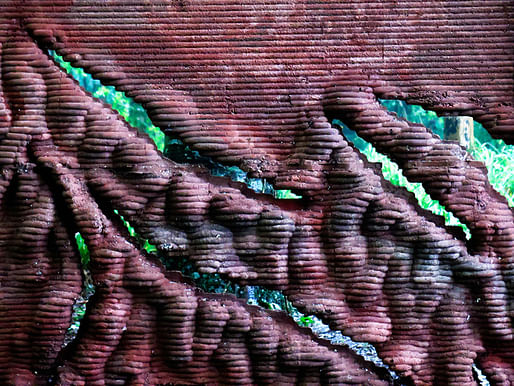
Contrasting against the greenery of Hooke Park is “InFlux”, a brick-red wall prototype that 18 students and their tutors assembled for the AA School of Architecture's Summer DLAB::RED 2015 program. Taking place from July 27 to August 8, the RED-themed agenda explored the phenomenal process of decay in nature.
InFlux builds upon the material behavior research that began in 2014, with further investigations that connect geometry, material, and structure. During the first two weeks, students investigated the fabrication and construction of double-curved complex geometries in applying generative design techniques and robotic milling strategies. Students then applied their skills in constructing the 1:1 working prototype during the last seven days of the program. Since then, InFlux has become a permanent installation at Hooke Park.
Also be on the lookout for more from 2016 Summer DLAB::ORANGE, which just started earlier this week.
Keep reading for more about InFlux's fabrication process:

Photo: Mathias Reisigl
“Realized as a wall with 2.2 meters height, 4 meters width, and a varying depth of 3 – 25 cm, InFlux has been developed, fabricated and assembled in 7 days. The research initiated on the material behaviour of concrete in 2014 has been developed in the 2015 cycle by further investigations linking geometry, material, and structure. Realized as a wall with 2.2 meters height, 4 meters width, and a varying depth of 3 - 25 cm.
Initial form-finding experiments have focused on the manipulation of a vertical planar geometry towards the creation of varying degrees of curvature through a range of computational techniques. Key parameters in this phase have comprised the distribution of openings and areas of local differentiated curvature values that stem from a global morphology. An agent-based model approach has been adopted for form-finding experiments, whereby a custom tool in Processing has been developed to manipulate mesh geometry locally, based on Z-coordinate data, via mesh relaxation techniques.”

Custom tool developed in Processing, mesh relaxation according to local data.
“The goal of the second set of computational experiments has been the integration of structural analysis tools from the outset of design explorations in order to inform global geometry and its structural performance. An initial mesh geometry has been evaluated under its self-weight via FEA analyses with the Grasshopper add-on Karamba as a shell structure, with material properties of high-strength concrete (C90/105). The force flow lines in the output mesh of Karamba have been visualized, with the aim of achieving wall openings which do not interfere with the transfer of loads throughout the global geometry. The FEA stage has been concluded with the creation of a 5 cm. deep shell split by openings following the direction of force flow within the wall.”

FEA analysis and resulting force-flow lines generated in Karamba.

Algorithmic generation of form-work data for concrete casting.
“The next stage in the computational design process entails the generation of doubly-curved geometries following the initial shell model as an input. The purpose of this investigation is two-fold, pertaining to structural performance and exploration of robotic milling techniques. The tool in Processing is developed further as a combination of agent-based simulation and mesh relaxation techniques with the purpose of creating a doubly-curved geometrical aggregation that increases in density towards the bottom section of the wall.
After the generation of openings, the mesh with its corresponding force flow lines has been imported in Processing for complex curvature generation. The agent system influences local mesh curvature throughout the overall form along the force flow lines following flocking and proximity rules.”

Robotically milled EPS formwork. Photo: Elif Erdine.
“Robotic fabrication processes in design allow for moving away from a direct design-to-production approach, whereby the final outcome is predefined and fabrication solely offers a means to an end. The tooling path of the robotic arm serves as a direct visual connection between the global geometry and local surface manipulation; therefore, the robotic end effector plays a crucial role as a design tool in the generation of localized surface textures on the global configuration.


Photos: Mathias Reisigl.
“The material for the form-work has been selected as medium density (30g/l) fire retardant grade expanded polystyrene (EPS) blocks, as EPS offers a suitable compromise between milling time and strength for form-work construction. The dimension of each EPS block is 200 cm in length, 125 cm in height, and 50 cm in depth, resulting with the employment of a total of 8 EPS blocks.
Throughout the design, fabrication, and assembly processes, the interactive associations between different simulation software have been a key driver in recognizing the ways of integrating architectural criteria with the structural performance of the pavilion. Overall, the research aims to illustrate the architectural possibilities of using concrete in a non-conventional way with limited resources and period of time by creating strong associations between computational design methodologies and digital fabrication processes.
Project credits:
Program Directors: Elif Erdine, Alexandros Kallegias
Tutors: Alexandros Kallegias, Elif Erdine, Daghan Cam, Angel Fernando, Lara Moreira
Students: Lorenzo Pellegrini, Jackson Lindsay, Xiaoxiang Li, Matthew Eng, Angelo Figliola, Nicolo Cernigliaro, Jos van Roosmalen, Areti Sanoudou-Dramalioti, Julian Heinen, Mathias Paul Reisigl, Stavroula Kakaletsi, Pallavi Gupta, Vikas Sharma, Emine Ece Emanetoglu, Leo Claudius Bieling, Florian Kaiser, Jin Li
Robotic Setup: Pradeep Devadass
No Comments
Block this user
Are you sure you want to block this user and hide all related comments throughout the site?
Archinect
This is your first comment on Archinect. Your comment will be visible once approved.